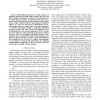40 search results - page 5 / 8 » Using Parsed Corpora for Structural Disambiguation in the TR... |
EMNLP
2007
13 years 8 months ago
2007
Following (Blitzer et al., 2006), we present an application of structural correspondence learning to non-projective dependency parsing (McDonald et al., 2005). To induce the corre...
BMCBI
2006
13 years 7 months ago
2006
Background: We study the adaptation of Link Grammar Parser to the biomedical sublanguage with a focus on domain terms not found in a general parser lexicon. Using two biomedical c...
LREC
2010
13 years 8 months ago
2010
This paper investigates whether high-quality annotations for tasks involving semantic disambiguation can be obtained without a major investment in time or expense. We examine the ...
ACL
2006
13 years 8 months ago
2006
When training the parameters for a natural language system, one would prefer to minimize 1-best loss (error) on an evaluation set. Since the error surface for many natural languag...
ISDA
2010
IEEE
13 years 5 months ago
2010
IEEE
Statistically-based parsers for large corpora, in particular the Penn Tree Bank (PTB), typically have not used all the linguistic information encoded in the annotated trees on whic...

